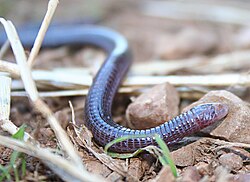| Blanus | |
|---|---|
 | |
| Iberian worm lizard (Blanus cinereus) | |
| Scientific classification | |
| Kingdom: | Animalia |
| Phylum: | Chordata |
| Class: | Reptilia |
| Order: | Squamata |
| Suborder: | Lacertoidea |
| Clade: | Amphisbaenia |
| Family: | Blanidae Kearney, 2003 |
| Genus: | Blanus Wagler, 1830 [1] |
Blanus, also known as worm lizards, are a genus of amphisbaenians found in the Mediterranean region of Europe and North Africa. [2] Like other amphisbaenians, Blanus species are specialized for a subterranean existence, with long, slender bodies, reduced limbs, and rudimentary eyes. Their skulls are powerfully constructed, allowing them to push through soil to create a burrow. Their jaws are well-developed, with large, recurved teeth and a pair of canine-like teeth in the upper jaw.
Contents
Four to seven extant species are currently known. The relationships of Blanus to other worm-lizards are not clear. The genus was formerly included in the Amphisbaenidae. More recent analyses suggest that blanids are more primitive, and are either related to Bipes [3] or represent an even more ancient lineage. [4]
A number of fossils from Europe have been referred either to Blanus or to the Blanidae. [5]
